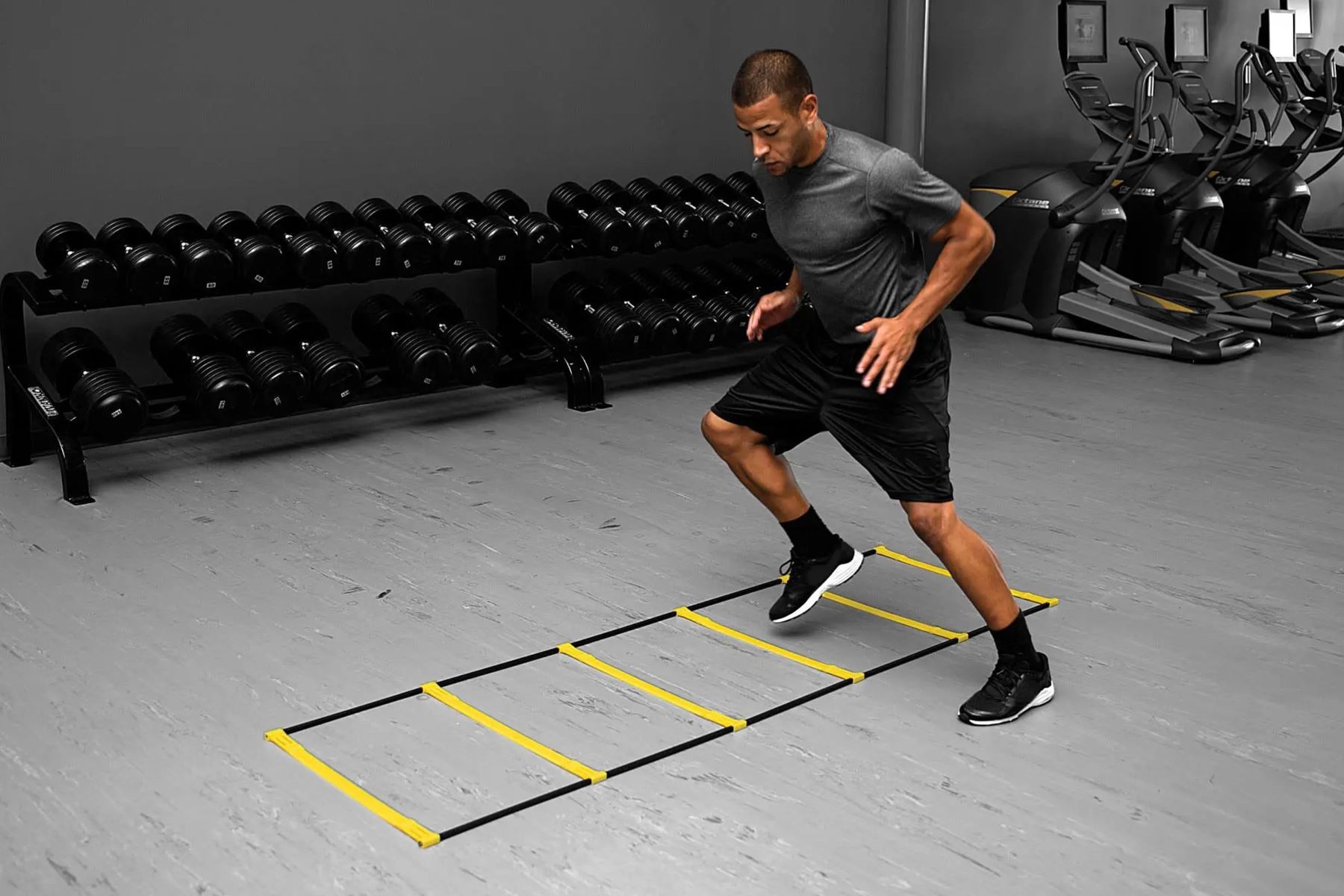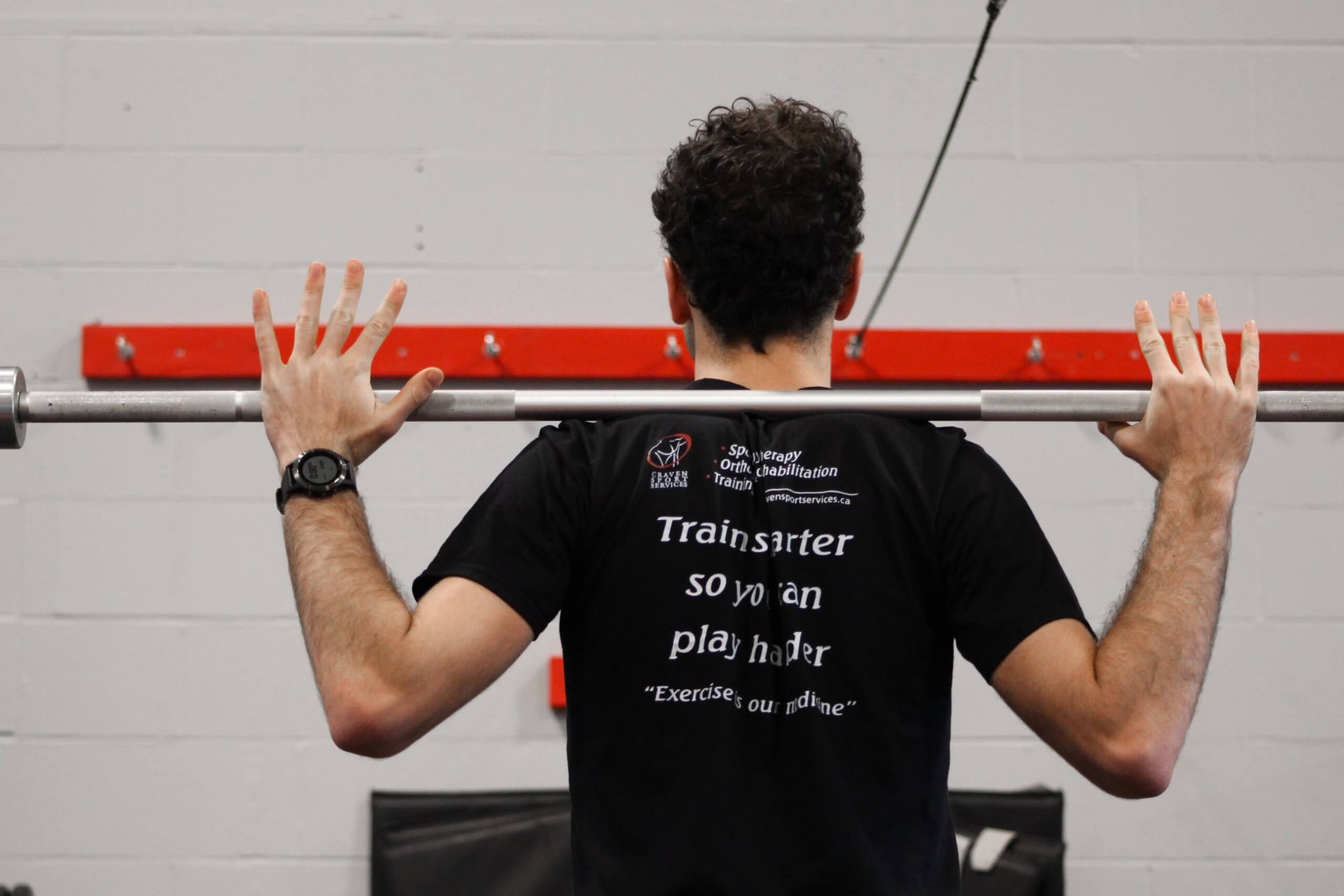

Featured
What Is A Ladder Workout
Modified: January 22, 2024
Discover the benefits of a ladder workout and how it can help you achieve your fitness goals. Get featured with this effective training method and elevate your workouts today!
Introduction
When it comes to fitness, it’s important to constantly challenge your body and avoid falling into a workout routine that becomes too predictable and stagnant. One effective way to keep your workouts fresh and stimulating is by incorporating ladder workouts into your training regimen.
A ladder workout is a versatile and dynamic exercise routine that involves progressive increases or decreases in intensity or repetitions. It is called a ladder workout because you can visualize the exercise as climbing up or down a ladder, with each rung representing a different level of intensity or challenge.
Whether you’re a beginner looking to improve your overall fitness level or an experienced athlete aiming to break through a plateau, ladder workouts can provide a valuable addition to your fitness routine. By constantly varying the intensity and repetitions, ladder workouts can help you build strength, endurance, and improve cardiovascular health.
In this article, we will explore the definition of a ladder workout, the numerous benefits it offers, how to structure a ladder workout, provide a sample routine, and offer some tips and safety precautions to keep in mind. So, let’s dive in and discover the exciting world of ladder workouts!
Definition of a Ladder Workout
A ladder workout is a style of exercise that involves gradually increasing or decreasing the intensity, duration, or repetitions of an exercise or set of exercises. It is a progressive training method that challenges your body to adapt and improve over time.
The name “ladder workout” derives from the visual representation of the workout, where you imagine yourself climbing up or down a ladder. Each rung of the ladder represents a different level of intensity, whether it be increasing weights, adding reps, or reducing resting periods.
For example, in a weightlifting ladder workout, you may start with a relatively light weight and perform a set number of repetitions. In each subsequent set, you gradually increase the weight and decrease the number of repetitions performed.
In a cardiovascular or HIIT (High-Intensity Interval Training) ladder workout, you may start with a short work interval and a longer rest interval. As you progress through the ladder, the work interval increases and the rest interval decreases.
The beauty of ladder workouts is their adaptability. You can apply the concept to various exercises and training modalities, making them suitable for individuals of all fitness levels and goals.
Ladder workouts can be used to target specific muscle groups, improve endurance, enhance cardiovascular fitness, or simply add variety to your routine.
By constantly challenging your body with incremental changes, ladder workouts prevent adaptation and ensure continued progress in your fitness journey.
Benefits of Ladder Workouts
Ladder workouts offer a multitude of benefits for individuals seeking to improve their fitness levels and overall well-being. Here are some of the key advantages:
- Versatility: Ladder workouts can be customized to suit various fitness goals and training modalities, making them suitable for individuals of all fitness levels and interests. Whether you want to increase strength, build endurance, or improve cardiovascular fitness, ladder workouts can be tailored to meet your specific needs.
- Progressive Overload: The gradual increase in intensity, duration, or repetitions in ladder workouts allows for progressive overload, a crucial principle for stimulating muscle growth and improvement. By continuously challenging your body to adapt to higher levels of stress, you can experience consistent progress and avoid plateaus.
- Efficiency: Ladder workouts are time-efficient, as they can be completed in a relatively short amount of time while still providing an effective workout. By packing multiple intensity levels into a single session, you can maximize your workout time and make the most of your training sessions.
- Mental Stimulation: The changing intensity and variety of ladder workouts help combat workout boredom and stimulate your mind. The constant adjustment and focus required to increase or decrease intensity levels keep you mentally engaged and motivated throughout the workout.
- Improved Cardiovascular Fitness: Ladder workouts that incorporate cardiovascular exercises such as running, cycling, or jumping jacks can effectively elevate your heart rate, improve cardiovascular fitness, and enhance your aerobic capacity.
- Muscle Conditioning: Ladder workouts that involve weightlifting or bodyweight exercises can help build strength, increase muscle endurance, and improve overall muscle conditioning. The progressive increase in weight or repetitions challenges your muscles and promotes growth and development.
With their versatility, efficiency, and capacity for progressive overload, ladder workouts are a fantastic addition to any fitness routine. Whether you are an athlete trying to improve performance or simply looking to enhance your overall fitness level, incorporating ladder workouts can help you achieve your goals in an effective and enjoyable manner.
How to Structure a Ladder Workout
Structuring a ladder workout involves careful planning and consideration to ensure a progressive and effective training session. Here are the key steps to create a well-structured ladder workout:
- Determine your exercise or exercises: Choose the exercises you want to incorporate into your ladder workout. These can include weightlifting exercises, bodyweight movements, cardiovascular activities, or a combination of different exercises.
- Set your starting point: Establish the starting point for your ladder workout. This can be the lightest weight, lowest intensity, or fewest repetitions. It’s important to choose a starting point that is challenging but manageable for your fitness level.
- Decide on the increments: Determine how you will progressively increase or decrease the intensity, duration, or repetitions. This can be done by adjusting the weight, changing the speed, decreasing the rest periods, or adding additional sets.
- Create the ladder: Construct the ladder by adding or subtracting increments from the starting point. Each rung of the ladder represents a different level of challenge or intensity. For example, in a weightlifting ladder workout, you may start with 10 repetitions at 50 pounds, then increase the weight and decrease the repetitions with each subsequent set.
- Choose the ladder pattern: Decide on the ladder pattern you want to follow. Common ladder patterns include ascending, descending, pyramid (ascending and then descending), or wave (alternating between increasing and decreasing).
- Set your goals: Determine your goals for the ladder workout. These can be specific performance targets, such as lifting a certain weight or completing a certain number of repetitions, or general goals like improving endurance or increasing muscular strength.
- Warm up: Begin your ladder workout with a proper warm-up to prepare your body for the upcoming challenges. This can include dynamic stretches, mobility exercises, or light cardiovascular activity.
- Execute the ladder: Start at the bottom rung of the ladder and work your way up or down, depending on the chosen pattern. Maintain proper form and technique throughout the workout to reduce the risk of injury and maximize effectiveness.
- Cool down: After completing the ladder workout, cool down with some static stretches or gentle movements to promote recovery and flexibility.
By following these steps, you can create a structured ladder workout that is tailored to your fitness level and goals. Remember to listen to your body, modify exercises as needed, and progress at a pace that is appropriate for you. Enjoy the challenge and excitement that ladder workouts bring to your fitness journey!
Sample Ladder Workout Routine
Here is an example of a ladder workout routine that incorporates both weightlifting exercises and cardiovascular movements:
Exercise: Squats
- Set 1: 10 reps at 50 pounds
- Set 2: 8 reps at 60 pounds
- Set 3: 6 reps at 70 pounds
- Set 4: 4 reps at 80 pounds
- Set 5: 2 reps at 90 pounds
Exercise: Push-ups
- Set 1: 15 reps
- Set 2: 12 reps
- Set 3: 9 reps
- Set 4: 6 reps
- Set 5: 3 reps
Exercise: Burpees
- Set 1: 20 seconds of work, 40 seconds of rest
- Set 2: 25 seconds of work, 35 seconds of rest
- Set 3: 30 seconds of work, 30 seconds of rest
- Set 4: 35 seconds of work, 25 seconds of rest
- Set 5: 40 seconds of work, 20 seconds of rest
This ladder workout routine follows an ascending ladder pattern for squats and push-ups, where the weight or repetitions increase with each set. For burpees, it follows a descending ladder pattern, where the work interval increases while the rest interval decreases.
Remember to customize the weights, repetitions, and duration to match your fitness level and goals. You can also add more exercises or modify the ladder pattern to suit your preferences and create a varied and challenging workout experience.
Ensure proper form and technique for each exercise, taking appropriate rest between sets if needed. Hydrate adequately throughout the workout and listen to your body’s signals to avoid overexertion or injury. Modify and adapt the routine as necessary to suit your individual needs and capabilities.
By incorporating this sample ladder workout routine into your fitness regimen, you can enjoy the benefits of progressive overload and challenge your body in a dynamic and engaging way.
Tips for Performing Ladder Workouts
Ladder workouts can be highly effective and rewarding, but they also require proper planning and execution for optimal results. Here are some essential tips to keep in mind when performing ladder workouts:
- Start with a proper warm-up: Always begin your ladder workout with a thorough warm-up routine to prepare your muscles and joints for the upcoming challenges. This can include dynamic stretches, light cardiovascular activity, and mobility exercises.
- Focus on proper form: Maintaining proper form is crucial during ladder workouts. Prioritize quality over quantity, ensuring that each repetition or movement is performed with correct technique and alignment. This reduces the risk of injury and maximizes the effectiveness of the workout.
- Listen to your body: Pay attention to your body’s signals and adjust the intensity or rest periods as needed. Push yourself, but avoid pushing beyond your limits to prevent overexertion or injury. Take breaks when necessary and modify exercises if required.
- Breathe and stay hydrated: Deep breathing helps fuel your muscles with oxygen, improving performance and preventing fatigue. Additionally, stay hydrated throughout the workout by drinking water regularly to maintain optimal performance and prevent dehydration.
- Gradually progress: As you become more comfortable with ladder workouts, gradually increase the challenge by adjusting the intensity, weight, or repetitions. This progressive overload will promote continued improvement and prevent plateaus in your fitness journey.
- Include rest and recovery: Rest is just as important as the workout itself. Allow adequate time for rest and recovery between ladder workouts to allow your body to repair and rebuild. This will help prevent burnout and support long-term progress.
- Mix it up: To keep your workouts exciting and prevent boredom, mix up the exercises and ladder patterns. Experiment with different movements, variations, and ladder combinations to challenge different muscle groups and keep your workouts fresh and engaging.
- Stay consistent: Consistency is key in any fitness routine. Aim to perform ladder workouts regularly, following a structured schedule that aligns with your goals. By staying consistent, you will experience greater progress and see noticeable improvements in your fitness level over time.
By implementing these tips, you can perform ladder workouts safely and effectively, maximizing the benefits and achieving your fitness goals. Remember to listen to your body, work at your own pace, and enjoy the journey of challenging and elevating your fitness potential.
Safety Considerations for Ladder Workouts
While ladder workouts can be a fantastic way to challenge your body and achieve your fitness goals, it is essential to prioritize safety during your training sessions. Here are some important safety considerations to keep in mind:
- Consult with a healthcare professional: If you have any underlying health conditions or concerns, it is always advisable to consult with a healthcare professional before starting any new exercise program, including ladder workouts.
- Warm up adequately: Prioritize a thorough warm-up routine before engaging in ladder workouts. This helps prepare your muscles, joints, and cardiovascular system for the demands of the workout and reduces the risk of injury.
- Use proper form and technique: Pay attention to your form and technique during each exercise to maintain proper alignment and reduce the risk of strain or injury. If you are unsure about proper form, consider seeking guidance from a qualified fitness professional.
- Progress gradually: Avoid the temptation to progress too quickly or use weights that are too heavy for your current fitness level. Gradually increase the challenge over time to allow your body to adapt and reduce the risk of overexertion or strain.
- Stay hydrated: Hydration is essential during any workout, including ladder workouts. Remember to drink water before, during, and after your training session to maintain proper fluid balance and prevent dehydration.
- Listen to your body: Pay attention to any signs of pain, discomfort, or fatigue during your ladder workouts. If you experience any intense or persistent pain, it is important to stop the exercise and seek appropriate medical attention if necessary.
- Modify exercises as needed: If you have any limitations or injuries, be prepared to modify exercises to accommodate your needs. There are often alternative movements or variations that can be used to work around limitations without compromising safety.
- Allow for adequate rest and recovery: Rest and recovery are crucial for the body to repair and rebuild after intense workouts. Schedule regular rest days, listen to your body’s cues, and give yourself ample time to recover between ladder workouts.
- Use appropriate equipment: Whether you are performing weightlifting exercises or cardiovascular movements, ensure that you have access to the proper equipment and use it correctly. This includes using proper footwear, adjusting weights and machines to the appropriate settings, and ensuring the equipment is in good working condition.
- Seek guidance if needed: If you are new to ladder workouts or unsure about any aspect of your training, consider working with a qualified fitness professional who can provide guidance, proper instruction, and ensure your safety throughout the process.
By following these safety considerations and making them a priority, you can enjoy the benefits of ladder workouts while minimizing the risk of injury. Remember, safety should always be your top priority to create a safe and effective exercise experience.
Conclusion
Ladder workouts offer a dynamic and effective approach to fitness training that can help you achieve your goals while keeping your routines exciting and challenging. By gradually increasing or decreasing the intensity, duration, or repetitions of exercises, ladder workouts provide progressive overload, ensuring continued progress and preventing plateaus.
Throughout this article, we explored the definition of ladder workouts, the benefits they offer, how to structure a ladder workout, and provided a sample routine. We also highlighted essential tips for performing ladder workouts and emphasized the importance of safety considerations.
From the versatility of ladder workouts to the efficiency and mental stimulation they provide, the advantages are numerous. Whether you’re seeking to increase strength, build endurance, or improve cardiovascular fitness, ladder workouts can be tailored to suit your needs and preferences.
Remember to always warm up properly, focus on maintaining proper form, listen to your body, and progress gradually. Safety should be a priority to prevent injuries and ensure long-term success in your fitness journey.
Now that you have a good understanding of ladder workouts, it’s time to apply this knowledge and incorporate them into your fitness routine. Experiment with different exercises, ladder patterns, and variations to keep your workouts fresh and engaging.
Get ready to climb the ladder of fitness success as you challenge your body, surpass your limits, and achieve new levels of strength, endurance, and overall fitness. Embrace the excitement and rewards that ladder workouts bring, and enjoy the journey toward a stronger, fitter, and healthier you!









